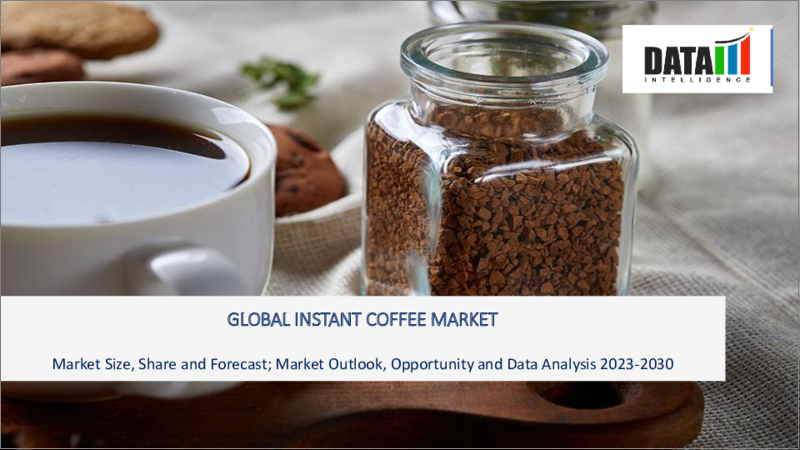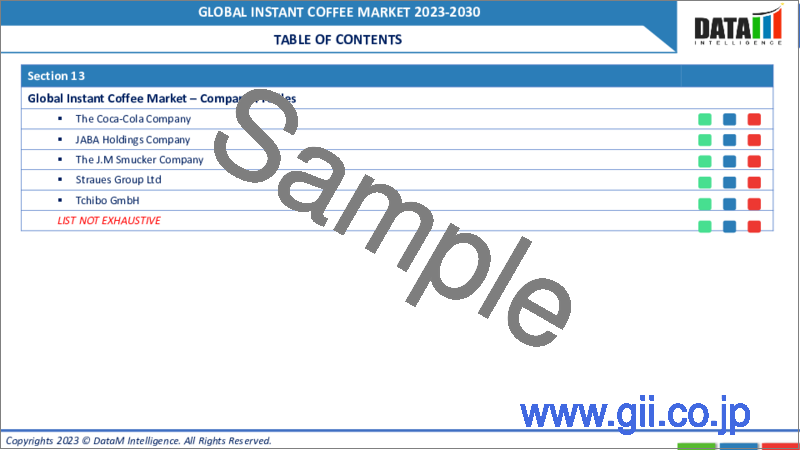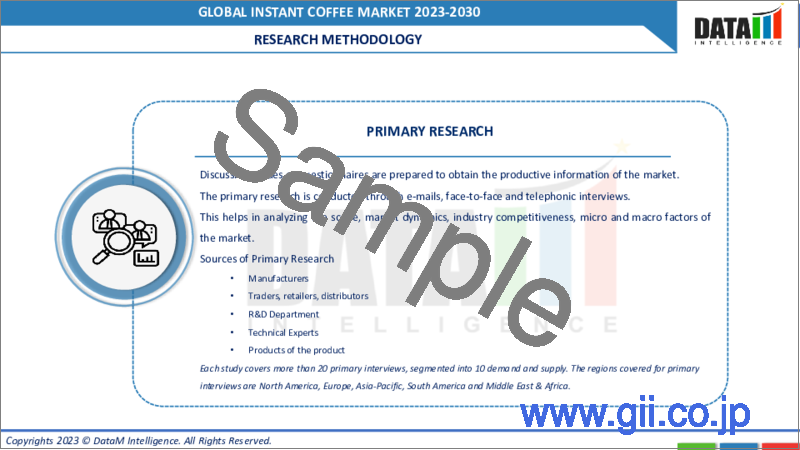|
|
市場調査レポート
商品コード
1285082
インスタントコーヒーの世界市場-2023-2030Global Instant Coffee Market - 2023-2030 |
||||||
|
● お客様のご希望に応じて、既存データの加工や未掲載情報(例:国別セグメント)の追加などの対応が可能です。 詳細はお問い合わせください。 |
|||||||
| インスタントコーヒーの世界市場-2023-2030 |
|
出版日: 2023年06月05日
発行: DataM Intelligence
ページ情報: 英文 135 Pages
納期: 約2営業日
|
- 全表示
- 概要
- 目次
市場の概要
世界のインスタントコーヒー市場は、2022年に312億3,620万米ドルに達し、2030年には486億6,960万米ドルにまで達して有利な成長を遂げると予測されています。同市場は予測期間中(2023年~2030年)、CAGR5.7%で成長しています。
世界のインスタントコーヒー市場は、コーヒー業界の中でも急速に成長し、進化しているセグメントです。利便性、消費者の嗜好の変化、技術革新などの要因に後押しされ、インスタントコーヒー市場は急速に拡大し多様化しています。スペシャルティコーヒーやグルメコーヒーなど、幅広い種類の高品質なインスタントコーヒー製品を入手できるようになったことが、インスタントコーヒー市場の需要を促進し、新しい消費者を惹きつける要因となっています。さらに、世界中で高まるコーヒー文化は、消費者がお気に入りのコーヒー製品を便利で簡単に楽しむ方法を求めているため、インスタントコーヒー市場に新たな機会をもたらしています。
市場力学
コーヒー文化の発展が市場成長を促進
世界のコーヒー文化の高まりは、世界のインスタントコーヒー市場を牽引する重要な役割を担っています。コーヒー業界におけるプレミアム化の動向は、淹れたてのコーヒーと同様の味と香りを提供する高品質のインスタントコーヒー製品の開発につながっています。このことが、インスタントコーヒー市場に多くの顧客層を引き寄せています。
例えば、2023年2月22日、Nestleが所有するBlue Bottle Coffeeは、プレミアム化を急速に受け入れている市場において、高度に専門的なコーヒーの選択肢を提供しようと、最新の少量生産コーヒー製品を発表しました。
インスタントコーヒーの技術革新が市場成長を促進する
インスタントコーヒーメーカーは、利便性と品質への要求が高まる消費者に、新しく改良されたインスタントコーヒー製品を提供するために、絶えず技術革新を行っています。また、パッケージの革新もインスタントコーヒー市場の成長を促進する上で極めて重要です。シングルサーブのサシェやポッドのイントロダクションは、消費者が外出先でインスタントコーヒーを楽しむことを容易にします。
例えば、2022年12月23日、ユネットグループは、従来のスクリューキャップチューブに対抗する構えの新しいTear n Tuck再閉鎖式サシェを発表しました。この革新的なパッケージングソリューションは、スクリューキャップチューブよりも70%少ないプラスチックで作られており、より軽量で費用対効果の高いものとなっています。
COVID-19の影響分析
COVID-19の流行は、世界のサプライチェーンを混乱させ、原材料の入手に影響を与え、価格の乱高下を引き起こしました。メーカーは、インスタントコーヒー製品の生産と流通を継続するために、これらの課題を克服する必要がありました。しかし、このパンデミックによって、消費者がインスタントコーヒー製品を購入するためにオンラインプラットフォームを利用するようになったため、eコマースの売上が増加したのです。
人工知能の影響分析
人工知能(AI)は、世界のインスタントコーヒー市場においてまだ新しい技術です。しかし、一部の企業は、品質管理や在庫管理など、コーヒー製品の生産・流通におけるAIの応用の可能性を探っています。AIを搭載したセンサーやモニタリングシステムは、生産プロセスの最適化、無駄の削減、効率化を実現し、コスト削減と収益性の向上につながります。また、消費者データや動向の分析にAIを活用することで、メーカーは特定の市場の需要に合わせて製品をカスタマイズすることが可能になります。
目次
第1章 調査手法とスコープ
- 調査手法
- 調査目的および調査範囲
第2章 定義と概要
第3章 エグゼクティブサマリー
- フレーバー別スニペット(Snippet by Flavoring
- パッケージ別
- 生産技術別スニペット
- 流通チャネル別
- 地域別スニペット
第4章 市場力学
- 影響要因
- 促進要因
- 抑制要因
- 機会
- 影響分析
第5章 産業分析
- ポーターのファイブフォース分析
- サプライチェーン分析
- 価格分析
- 法規制の分析
第6章 COVID-19の分析
- COVID-19の分析
- COVID-19の前のシナリオ
- COVID-19期間中のシナリオ
- COVID-19後のシナリオ、または将来のシナリオ
- COVID-19の中での価格・ダイナミクス
- 需給スペクトル
- パンデミック時の市場に関連する政府の取り組み
- メーカーの戦略的な取り組み
- サマリー
第7章 フレーバー別
- フレーバーインスタントコーヒー
- ノンフレーバーインスタントコーヒー
第8章 パッケージ別
- 小袋
- パウチ
- ジャー
第9章 製造技術別
- フリーズドライインスタントコーヒー
- スプレードライインスタントコーヒー
第10章 流通チャネル別
- スーパーマーケット/ハイパーマーケット
- コンビニエンスストア
- 専門店
- オンラインチャネル
- その他
第11章 地域別
- 北米
- 米国
- カナダ
- メキシコ
- 欧州
- ドイツ
- 英国
- フランス
- イタリア
- スペイン
- その他欧州
- 南米
- ブラジル
- アルゼンチン
- その他南米地域
- アジア太平洋地域
- 中国
- インド
- 日本
- オーストラリア
- その他アジア太平洋地域
- 中東・アフリカ地域
第12章 競合情勢
- 競合シナリオ
- 市況/シェア分析
- M&A(合併・買収)分析
第13章 企業プロファイル
- Nestle SA
- 会社概要
- 製品ポートフォリオと説明
- 財務概要
- 主な発展状況
- Unilever PLC
- Kraft Foods Inc
- Starbucks Corporation
- Tata Global Beverages Limited
- The Coca-Cola Company
- JABA Holdings Company
- The J.M Smucker Company
- Straues Group Ltd
- Tchibo GmbH
第14章 付録
Market Overview
The global instant coffee market reached US$ 31,236.2 million in 2022 and is projected to witness lucrative growth by reaching up to US$ 48,669.6 million by 2030. The market is growing at a CAGR of 5.7% during the forecast period (2023-2030).
The global instant coffee market is a rapidly growing and evolving segment of the coffee industry. Driven by factors such as convenience, changing consumer preferences, and innovation, the instant coffee market is expanding and diversifying at a rapid pace. The availability of a wide range of high-quality instant coffee products, including specialty and gourmet options, has helped to drive instant coffee market demand and attract new consumers. In addition, the growing coffee culture around the world is creating new opportunities for the instant coffee market, as consumers look for convenient and easy ways to enjoy their favorite coffee products.
Market Dynamics
Growing Coffee Culture Drives The Market Growth
The growing coffee culture around the world plays a significant role in driving the global instant coffee market. The rising trend of premiumization in the coffee industry is leading to the development of high-quality instant coffee products that offer a similar taste and aroma as that of freshly brewed coffee. This is attracting a larger customer base to the instant coffee market.
For instance, on February 22, 2023, Blue Bottle Coffee, which is owned by Nestle, launched its latest small-batch coffee product in an effort to provide a highly specialized coffee option in a market that is quickly embracing premiumization.
Innovations in Instant Coffee Drive The Market Growth
Manufacturers are continuously innovating to offer new and improved instant coffee products to consumers with the growing demand for convenience and quality. Packaging innovations have also been crucial in driving instant coffee market growth. The introduction of single-serve sachets and pods makes it easier for consumers to enjoy instant coffee on the go.
For instance, on December 23, 2022, the Unette Group introduced its new Tear n Tuck re-closable sachet, which is poised to compete with the traditional screw cap tube. This innovative packaging solution is made with 70% less plastic than the screw cap tube, making it more lightweight and cost-effective.
COVID-19 Impact Analysis
The COVID-19 pandemic disrupted global supply chains, affected the availability of raw materials, and caused price volatility. Manufacturers had to navigate these challenges to ensure the continued production and distribution of instant coffee products. However, the pandemic has led to an increase in e-commerce sales, as consumers have increasingly turned to online platforms for purchasing instant coffee products.
Artificial Intelligence Impact Analysis
Artificial intelligence (AI) is still a new technology in the global instant coffee market. However, some companies are exploring the potential applications of AI in the production and distribution of coffee products, such as quality control and inventory management. AI-powered sensors and monitoring systems can help optimize production processes, reduce waste, and improve efficiency, leading to cost savings and increased profitability. AI can also be used to analyze consumer data and trends, allowing manufacturers to tailor their products to meet specific market demands.
Segment Analysis
The global instant coffee market is segmented based on flavoring, packaging, production technology, distribution channel, and region.
Increased Demand For Shelf-Life Coffee Products Is Expected To Drive The Segment Growth
Freeze-dried instant coffee has held the largest share of the global instant coffee market. The method of freeze-drying coffee preserves its natural aroma and flavor, making it a popular choice among consumers. Many leading coffee brands use freeze-drying technology to produce their instant coffee products.
For instance, on January 3, 2023, Continental Coffee introduced its inaugural national television commercial featuring its Continental Freeze-Dried product. The brand's Freeze-Dried coffee is renowned for its purity and is considered one of the best in its category. The product stands out due to its use of high-quality Arabica coffee beans sourced from the best Indian plantations.
Geographical Analysis
Increased Consumption Of Instant Coffee in Asia Pacific
The Asia-Pacific region has emerged as the dominant player in the global instant coffee market, accounting for the largest market share. This growth can be attributed to the increasing urbanization and rising disposable income levels of the population in countries such as China and India. India has emerged as a significant contributor to the growth of the instant coffee market in the Asia-Pacific region. The country has a rich coffee culture, with coffee being one of the most preferred beverages among consumers. To meet the consumer demand, manufacturers launch new products.
For instance, on June 4, 2021, TCPL ventured into the premium coffee segment with the launch of 'Sonnets By Tata Coffee', targeting customers who seek a unique and exclusive coffee experience. The brand marks TCPL's entry into the premium roast and ground coffee category, providing consumers with a distinct and premium offering.
Competitive Landscape
The major global instant coffee market players include: Nestle SA, Unilever PLC, Kraft Foods Inc, Starbucks Corporation, Tata Global Beverages Limited, The Coca-Cola Company, JABA Holdings Company, The J.M Smucker Company, Straues Group Ltd, and Tchibo GmbH.
Why Purchase the Report?
- To visualize the global instant coffee market segmentation based on flavoring, packaging, production technology, distribution channel, and region, as well as understand key commercial assets and players.
- Identify commercial opportunities by analyzing trends and co-development.
- Excel data sheet with numerous data points of instant coffee market-level with all segments.
- PDF report consists of a comprehensive analysis after exhaustive qualitative interviews and an in-depth study.
- Product mapping available as Excel consisting of key products of all the major players.
The global instant coffee market report would provide approximately 69 tables, 66 figures, and 135 Pages.
Target Audience 2023
- Manufacturers/ Buyers
- Industry Investors/Investment Bankers
- Research Professionals
- Emerging Companies
Table of Contents
1. Methodology and Scope
- 1.1. Research Methodology
- 1.2. Research Objective and Scope of the Report
2. Definition and Overview
3. Executive Summary
- 3.1. Snippet by Flavoring
- 3.2. Snippet by Packaging
- 3.3. Snippet by Production Technology
- 3.4. Snippet by Distribution Channel
- 3.5. Snippet by Region
4. Dynamics
- 4.1. Impacting Factors
- 4.1.1. Drivers
- 4.1.2. Restraints
- 4.1.3. Opportunity
- 4.1.4. Impact Analysis
5. Industry Analysis
- 5.1. Porter's Five Forces Analysis
- 5.2. Supply Chain Analysis
- 5.3. Pricing Analysis
- 5.4. Regulatory Analysis
6. COVID-19 Analysis
- 6.1. Analysis of COVID-19
- 6.1.1. Scenario Before COVID-19
- 6.1.2. Scenario During COVID-19
- 6.1.3. Post COVID-19 or Future Scenario
- 6.2. Pricing Dynamics Amid COVID-19
- 6.3. Demand-Supply Spectrum
- 6.4. Government Initiatives Related to the Market During Pandemic
- 6.5. Manufacturers Strategic Initiatives
- 6.6. Conclusion
7. By Flavoring
- 7.1. Introduction
- 7.1.1. Market Size Analysis and Y-o-Y Growth Analysis (%), By Flavoring
- 7.1.2. Market Attractiveness Index, By Flavoring
- 7.2. Flavored Instant Coffee*
- 7.2.1. Introduction
- 7.2.2. Market Size Analysis and Y-o-Y Growth Analysis (%)
- 7.3. Unflavored Instant Coffee
8. By Packaging
- 8.1. Introduction
- 8.1.1. Market Size Analysis and Y-o-Y Growth Analysis (%), By Packaging
- 8.1.2. Market Attractiveness Index, By Packaging
- 8.2. Sachets*
- 8.2.1. Introduction
- 8.2.2. Market Size Analysis and Y-o-Y Growth Analysis (%)
- 8.3. Pouches
- 8.4. Jars
9. By Production Technology
- 9.1. Introduction
- 9.1.1. Market Size Analysis and Y-o-Y Growth Analysis (%), By Production Technology
- 9.1.2. Market Attractiveness Index, By Production Technology
- 9.2. Freeze-Dried Instant Coffee*
- 9.2.1. Introduction
- 9.2.2. Market Size Analysis and Y-o-Y Growth Analysis (%)
- 9.3. Spray-Dried Instant Coffee
10. By Distribution Channel
- 10.1. Introduction
- 10.1.1. Market Size Analysis and Y-o-Y Growth Analysis (%), By Distribution Channel
- 10.1.2. Market Attractiveness Index, By Distribution Channel
- 10.2. Supermarkets/Hypermarkets*
- 10.2.1. Introduction
- 10.2.2. Market Size Analysis and Y-o-Y Growth Analysis (%)
- 10.3. Convenience Stores
- 10.4. Specialist Retailers
- 10.5. Online Channels
- 10.6. Others
11. By Region
- 11.1. Introduction
- 11.1.1. Market Size Analysis and Y-o-Y Growth Analysis (%), By Region
- 11.1.2. Market Attractiveness Index, By Region
- 11.2. North America
- 11.2.1. Introduction
- 11.2.2. Key Region-Specific Dynamics
- 11.2.3. Market Size Analysis and Y-o-Y Growth Analysis (%), By Flavoring
- 11.2.4. Market Size Analysis and Y-o-Y Growth Analysis (%), By Packaging
- 11.2.5. Market Size Analysis and Y-o-Y Growth Analysis (%), By Production Technology
- 11.2.6. Market Size Analysis and Y-o-Y Growth Analysis (%), By Distribution Channel
- 11.2.7. Market Size Analysis and Y-o-Y Growth Analysis (%), By Country
- 11.2.7.1. The U.S.
- 11.2.7.2. Canada
- 11.2.7.3. Mexico
- 11.3. Europe
- 11.3.1. Introduction
- 11.3.2. Key Region-Specific Dynamics
- 11.3.3. Market Size Analysis and Y-o-Y Growth Analysis (%), By Flavoring
- 11.3.4. Market Size Analysis and Y-o-Y Growth Analysis (%), By Packaging
- 11.3.5. Market Size Analysis and Y-o-Y Growth Analysis (%), By Production Technology
- 11.3.6. Market Size Analysis and Y-o-Y Growth Analysis (%), By Distribution Channel
- 11.3.7. Market Size Analysis and Y-o-Y Growth Analysis (%), By Country
- 11.3.7.1. Germany
- 11.3.7.2. The U.K.
- 11.3.7.3. France
- 11.3.7.4. Italy
- 11.3.7.5. Spain
- 11.3.7.6. Rest of Europe
- 11.4. South America
- 11.4.1. Introduction
- 11.4.2. Key Region-Specific Dynamics
- 11.4.3. Market Size Analysis and Y-o-Y Growth Analysis (%), By Flavoring
- 11.4.4. Market Size Analysis and Y-o-Y Growth Analysis (%), By Packaging
- 11.4.5. Market Size Analysis and Y-o-Y Growth Analysis (%), By Production Technology
- 11.4.6. Market Size Analysis and Y-o-Y Growth Analysis (%), By Distribution Channel
- 11.4.7. Market Size Analysis and Y-o-Y Growth Analysis (%), By Country
- 11.4.7.1. Brazil
- 11.4.7.2. Argentina
- 11.4.7.3. Rest of South America
- 11.5. Asia-Pacific
- 11.5.1. Introduction
- 11.5.2. Key Region-Specific Dynamics
- 11.5.3. Market Size Analysis and Y-o-Y Growth Analysis (%), By Flavoring
- 11.5.4. Market Size Analysis and Y-o-Y Growth Analysis (%), By Packaging
- 11.5.5. Market Size Analysis and Y-o-Y Growth Analysis (%), By Production Technology
- 11.5.6. Market Size Analysis and Y-o-Y Growth Analysis (%), By Distribution Channel
- 11.5.7. Market Size Analysis and Y-o-Y Growth Analysis (%), By Country
- 11.5.7.1. China
- 11.5.7.2. India
- 11.5.7.3. Japan
- 11.5.7.4. Australia
- 11.5.7.5. Rest of Asia-Pacific
- 11.6. Middle East and Africa
- 11.6.1. Introduction
- 11.6.2. Key Region-Specific Dynamics
- 11.6.3. Market Size Analysis and Y-o-Y Growth Analysis (%), By Flavoring
- 11.6.4. Market Size Analysis and Y-o-Y Growth Analysis (%), By Packaging
- 11.6.5. Market Size Analysis and Y-o-Y Growth Analysis (%), By Production Technology
- 11.6.6. Market Size Analysis and Y-o-Y Growth Analysis (%), By Distribution Channel
12. Competitive Landscape
- 12.1. Competitive Scenario
- 12.2. Market Positioning/Share Analysis
- 12.3. Mergers and Acquisitions Analysis
13. Company Profiles
- 13.1. Nestle SA*
- 13.1.1. Company Overview
- 13.1.2. Product Portfolio and Description
- 13.1.3. Financial Overview
- 13.1.4. Key Developments
- 13.2. Unilever PLC
- 13.3. Kraft Foods Inc
- 13.4. Starbucks Corporation
- 13.5. Tata Global Beverages Limited
- 13.6. The Coca-Cola Company
- 13.7. JABA Holdings Company
- 13.8. The J.M Smucker Company
- 13.9. Straues Group Ltd
- 13.10. Tchibo GmbH
LIST NOT EXHAUSTIVE
14. Appendix
- 14.1. About Us and Services
- 14.2. Contact Us




